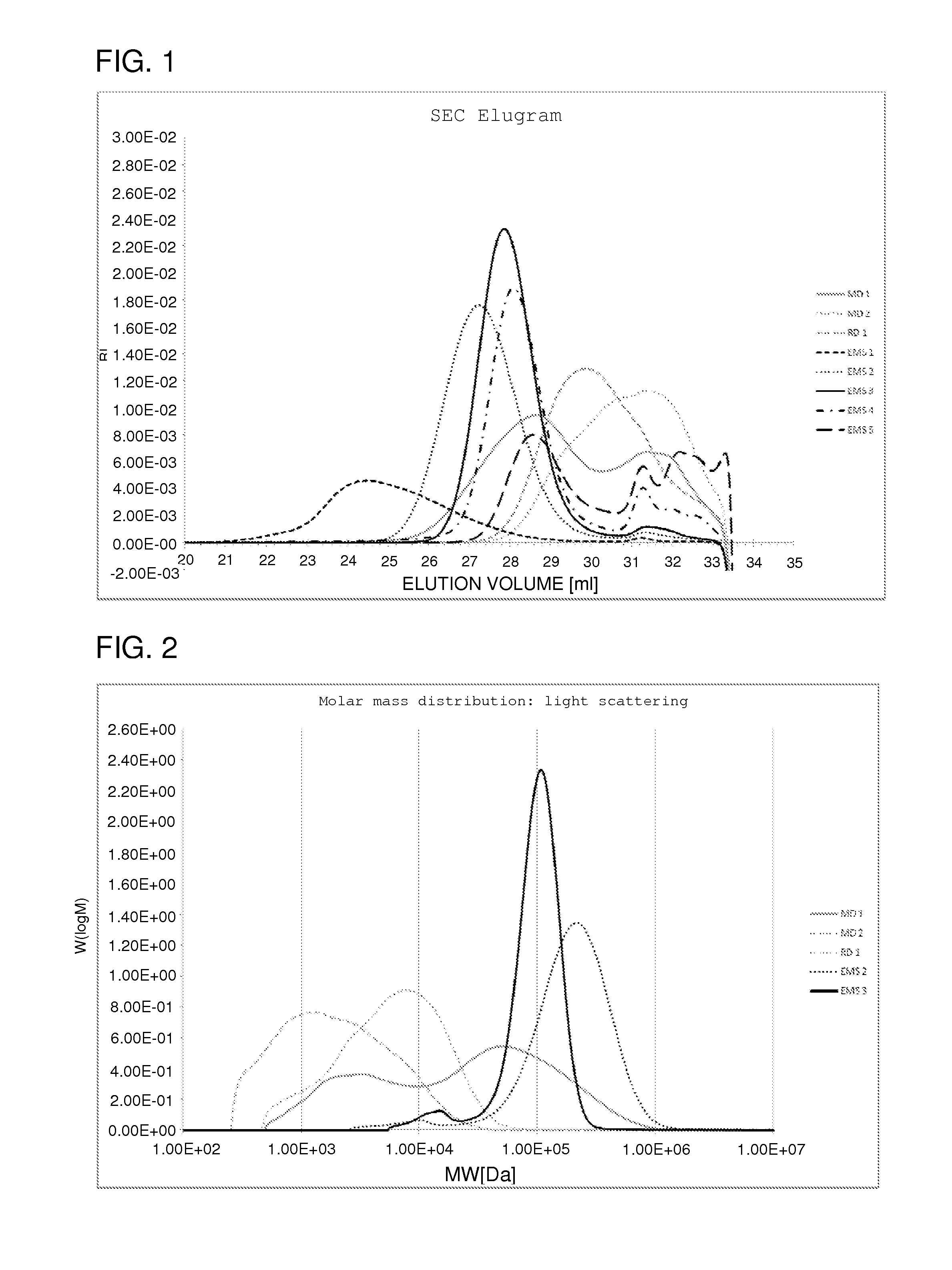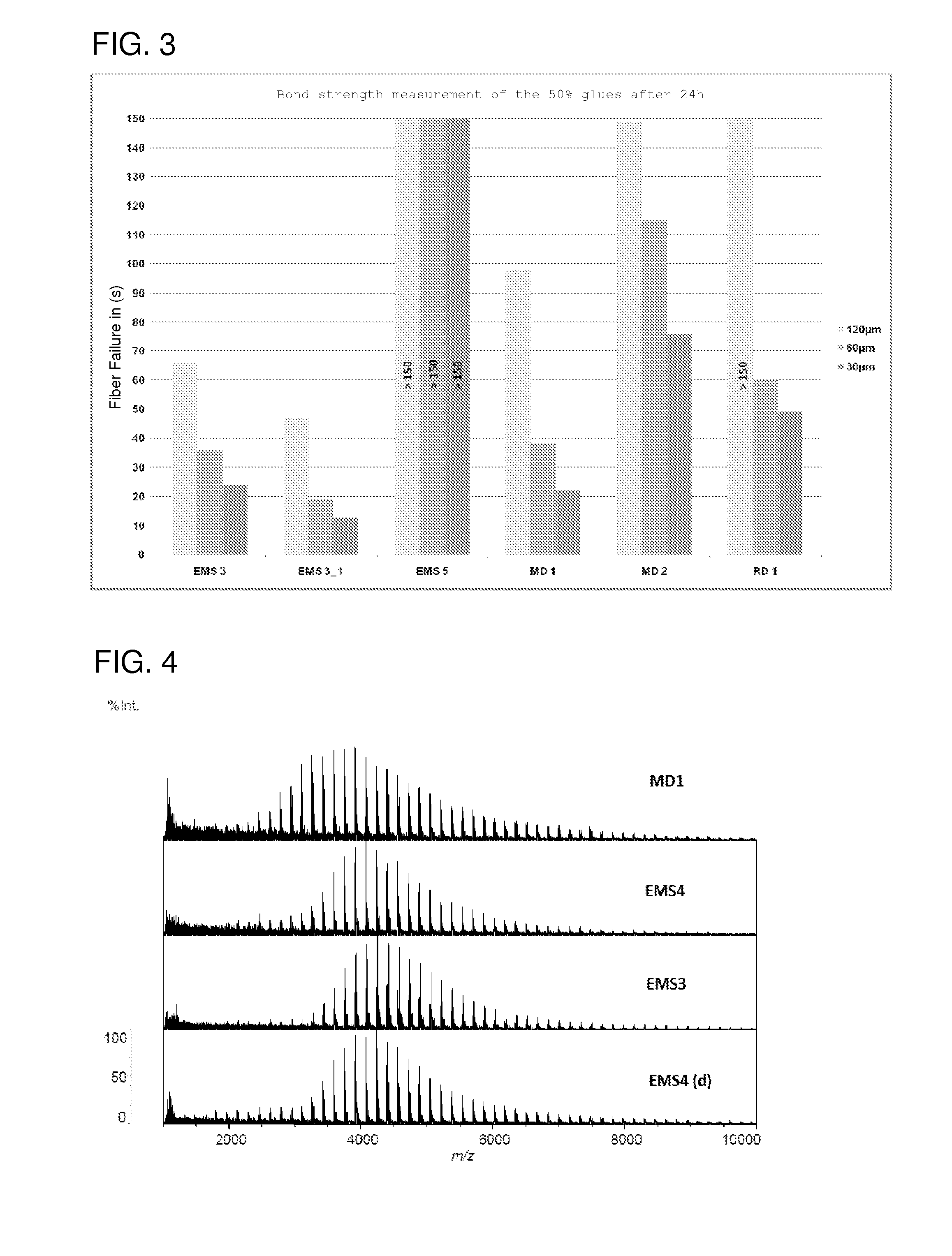Starch-based glue composition
a starch-based glue and composition technology, applied in the field of starch-based glue composition, to achieve the effects of high solid content, low viscosity, and high adhesive for
- Summary
- Abstract
- Description
- Claims
- Application Information
AI Technical Summary
Benefits of technology
Problems solved by technology
Method used
Image
Examples
example 1
Preparation of a Highly-Branched Starch (Ems3)
[0099]Materials:
a. waxy maize starch Maisita 21.007;
b. branching enzyme NS28067, (activity of 50,000 BEU / g solution);
d. hydrochloric acid; and
e. filtering aid.
[0100]100 g of waxy maize starch (dry substance) were mixed in with distilled water to form a 10% slurry. This slurry was agglutinated (95° C.) with constant stirring (propeller stirrer). The starch began to agglutinate from a temperature of approximately 70 to 75° C. The temperature of 95° C. was maintained for 1 hour to ensure complete starch digestion. After cooling to 75° C., the pH value of the paste was set to pH 6 (0.1 N hydrochloric acid or 0.1 N sodium hydroxide solution). The enzyme was then added (1,000 BEU / g of starch). In order to obtain other products, 20 BEU / g to 1,000,000 BEU / g were alternatively used. The moment of enzyme addition is defined as the start of the reaction. The initial relatively thick paste became gradually runny after ad...
example 2
Preparation of the Paste
[0101]Distilled water (250 g) was introduced into a 400 ml beaker glass (high type) and, for 40%, 100 g in dry substance (i.DS) were weighed in, and for 50% 125 g starch i.DS were weighed in. Stirring occurred using a Heidolph stirrer and a toothed-disc stirrer (diameter 4 cm). The sample was interspersed quickly, without clump formation where possible, at 1000 rpm and stirred for 10 min. In order to ensure the biological stability of the glues prepared, each glue was mixed with 1% biocide solution based on the starch.
[0102]The first viscosity measurements were taken directly after the stirringin process. The glues were then filled into screw-cap jars for storage and stored at constant temperature.
example 3
Determination of Viscosity
[0103]The starch pastes prepared by the above-described method or a liquid starch may be used directly to determine viscosity. Viscosity was calculated with the aid of a Brookfield-RV viscosimeter (DVII+Viscosimeter) at 22.5° C. and at a rotational speed of 100 rpm of spindle 4.
[0104]The first measurement was taken directly after preparation of the paste, further measurements being taken after 2 hr, 24 hr, 7 days and 14 days to assess viscosity stability. For this purpose, the stability index value (SI) was used, that is to say the quotient from viscosity after 14 days and 2 hr. Values around 1 demonstrate good viscosity stability: the higher the value, the more pronounced the subsequent thickening. Set samples were given with an SI value greater than 10.
PUM
| Property | Measurement | Unit |
|---|---|---|
| weight average | aaaaa | aaaaa |
| polydispersity index PDI | aaaaa | aaaaa |
| polydispersity index PDI | aaaaa | aaaaa |
Abstract
Description
Claims
Application Information
 Login to View More
Login to View More - R&D
- Intellectual Property
- Life Sciences
- Materials
- Tech Scout
- Unparalleled Data Quality
- Higher Quality Content
- 60% Fewer Hallucinations
Browse by: Latest US Patents, China's latest patents, Technical Efficacy Thesaurus, Application Domain, Technology Topic, Popular Technical Reports.
© 2025 PatSnap. All rights reserved.Legal|Privacy policy|Modern Slavery Act Transparency Statement|Sitemap|About US| Contact US: help@patsnap.com


